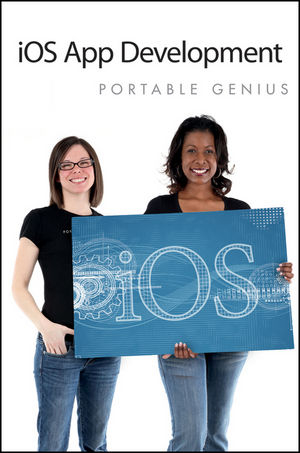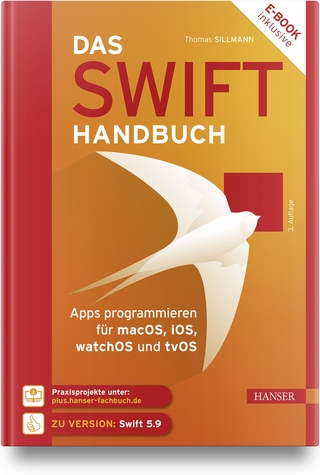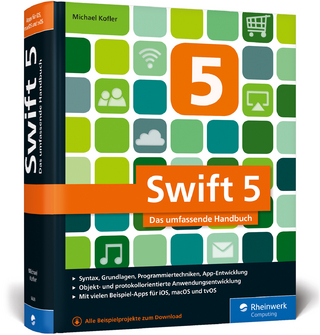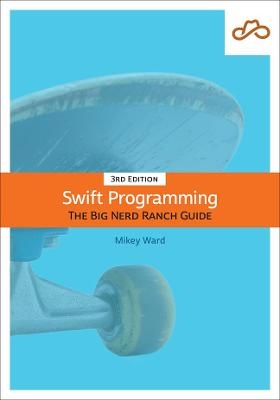
IOS App Development Portable Genius
John Wiley & Sons Inc (Verlag)
978-1-118-32989-4 (ISBN)
- Titel ist leider vergriffen;
keine Neuauflage - Artikel merken
The essential skills and technologies needed for iOS development in one handy guide! The unprecedented popularity of iOS devices, such as the iPhone, iPad, and iPod touch, has led to a development boom. If you re eager to become part of the action, then this is the book for you! Packed with must-have information on iOS development, this handy guide covers Objective-C, Xcode, Frameworks, and sound design principles and explains how to upload an app to the app store and integrate apps with the latest advances that Apple offers developers. The featured tips and tricks will get you up and running and sharpen your skills as an iOS developer. * Gets savvy beginning developers started with iOS development while also keeping experienced iOS developers up to date on the latest in this field * Features easy-to-follow instructions on the strong and stable iOS platform iOS Development Portable Genius covers all the essentials you need to get started with iOS development today.
Richard Wentk is a developer with more than fifteen years of experience in publishing, and is one of the UK's most reliable technology writers. He covers Apple products and developments for Macworld and MacFormat magazines, and also writes about technology and business strategy.
Acknowledgments vii Introduction xviii chapter 1 How Can I Start Developing for iOS? 2 Getting Started with App Development 4 Choosing a Mac 6 Choosing a processor 6 Selecting memory 7 Selecting a monitor 8 Selecting other peripherals 8 Selecting a form factor 9 Running Xcode on a laptop 9 Running Xcode on an iMac 9 Running Xcode on a Mac Pro 10 Running Xcode on a Mac Mini 10 Joining the iOS Developer Program 11 Understanding enrollment options 11 Enrolling in the iOS Developer Program 12 Downloading and Installing Xcode 14 Understanding SDKs and betas 14 Installing Xcode from the App Store 15 Installing Xcode from a developer download 17 Understanding other installation requirements 19 Updating devices 20 Installing documentation 22 chapter 2 How Do I Get Started with Xcode? 24 Understanding Xcode 26 Introducing Xcode s User Interface 28 Introducing the main Xcode window 29 Viewing and hiding UI features 31 Using the View buttons 32 Using the Editor buttons 33 Understanding the Assistant Editor 34 Understanding the Version Editor 35 Using the Organizer 36 Using the other toolbar features 37 Introducing the Navigator area 37 Using the Project navigator 38 Listing and grouping project files 39 Viewing build settings 40 Introducing the Editor area 41 Introducing iOS and the Apple Documentation 43 Understanding Resource Types 45 Understanding Topics 46 Understanding frameworks and layers 47 Using the documentation browser 50 Accessing the documentation 51 Accessing documentation in the Organizer 51 Accessing the documentation from a web browser 52 Getting Further Help 53 Putting It All Together 55 chapter 3 How Do I Build and Run an Application? 56 Building Applications 58 Creating a new project 58 Building a project 61 Working with the Simulator 64 Understanding Xcode s Project Templates 64 Creating iPhone, iPad, and Universal projects 65 Exploring the app templates 67 Master-Detail Application 67 OpenGL Game 68 Page-Based Application 69 Single-View Application 69 Tabbed Application 70 Utility Application 71 Empty Application 72 Customizing and expanding templates 73 Building Apps from Sample Code 75 Building sample projects from the documentation 75 Loading projects from the Organizer 76 Loading projects from the online documentation 78 Building sample projects from other sources 80 Building Apps for Test Devices 81 Understanding certificates and provisioning 81 Creating certificates and provisioning profiles 82 Using devices for testing 84 chapter 4 What Are Applications Made Of? 86 Understanding Applications 88 Understanding messages 88 Using messages in practice 90 Understanding code 90 Understanding messages in objects 95 Building apps from messages 96 Understanding App Structure 97 Understanding message timing 99 Working with message timing 100 Introducing Views, Nib Files, and Storyboards 101 Looking at nib files 102 Adding objects to a UI 103 Understanding the view hierarchy 105 Modifying views and the view hierarchy 106 Understanding Views and Controllers 108 Introducing storyboards 108 Introducing Model-View-Controller (MVC) 109 Using MVC 110 Working with MVC messages 111 Appreciating Graphic Design 112 Summarizing UI Creation 113 chapter 5 How Do I Create Code? 114 Introducing Code Design 116 Organizing data 116 Mixing C and Objective-C 117 Editing and Building Code 118 Understanding Errors and Warnings 119 Understanding compile-time errors 119 Understanding warnings 120 Understanding run-time errors 120 Understanding the C Language 121 Understanding computers 122 Representing data in C 123 Using text in C 124 Using numbers in C 125 Creating a Simple App in C 126 Adding code 126 Managing data 129 Naming variables 130 Displaying variables 130 Working with memory 132 Introducing pointers 133 Grouping data 134 Introducing arrays 134 Introducing structs 135 Making decisions 136 Repeating code 137 Re-using code with functions 138 Understanding scope 140 Using other C idioms 141 Bitwise operations 141 Manipulating numbers 142 Converting between types 143 Using the standard library 143 chapter 6 How Do I Use Objects in My Code? 146 Moving from C to Objective-C 148 Thinking with objects 148 Understanding classes 149 Understanding inheritance 151 Exploring messaging and behaviors 152 Introducing Objective-C Code 154 Working with messages and properties 154 Creating objects 157 Defining Classes in Your App 157 Using premade subclasses 159 Understanding the interface file 160 Looking at an interface file 161 Looking at an implementation file 163 Using @synthesize 164 Adding your own subclasses 164 Using subclassing 167 Adding features 168 Overriding methods 169 Exploring touch messages 170 Getting started 171 Going Deeper with Objective-C 174 Introducing selectors 174 Using Target-Action 175 Getting started with delegates and protocols 176 Class methods 177 chapter 7 How Can I Use Objects to Manage Data and Schedule Events? 180 Managing Text with NSString 182 Creating a string 182 Comparing strings 183 Managing Data Collections 184 Understanding mutable collections 186 Understanding objectification 188 Using NSNumber 189 Using NSValue 190 Using NSData 192 Understanding key-value coding (KVC) 192 Basic KVC 192 Using KVC with NSDictionary 194 Using NSSet 196 Processing objects in collections 198 Running methods on objects in a collection 198 Checking method availability 199 Key-value observing (KVO) 200 Scheduling Events 202 Creating a simple delay 202 Creating a simple timer 203 Scheduling an event at a future time 204 chapter 8 How Do I Handle Input from the User? 206 Understanding User Interaction 208 Introducing actions, outlets, and responder events 208 Working with actions, outlets, and responder events 208 Working with Action Messages 209 Working with action messages in IB 210 Adding a button to a view 210 Customizing the appearance of a control 211 Creating event handlers in code 214 Filling in an event handler 217 Editing action connections 218 Deleting a connection 218 Creating connections manually 219 Connecting a method to an object 220 Connecting an object to a method 222 Understanding (id) sender 222 Creating and Using Outlets 224 Creating an outlet 224 Using an outlet 227 Using the Responder System 229 Working with a text field 230 Working with touch events 232 Working with single touch events 232 Working with multi-touch 234 Introducing gestures 236 Working with gesture recognizers 236 Subclassing in IB 238 chapter 9 What Are Frameworks and How Do I Use Them? 242 Understanding Frameworks 244 Understanding iOS frameworks 244 Introducing third-party frameworks 247 Adding an iOS Framework to a Project 249 Finding the framework you need 249 Adding a framework to a project 250 Including framework header files 252 Adding objects from a framework to your project 254 Understanding Delegates and Protocols 256 Understanding delegates 256 Using delegates and protocols 258 Adding a Third-Party Framework to a Project 261 chapter 10 How Do I Add Custom Graphics to My App? 266 Understanding UI Design 268 Creating an excellent UI 268 Designing a UI step by step 269 Sourcing Custom Graphics 271 Finding clip art and icons 271 Creating art manually 272 Paying a graphic designer 274 Using Custom Graphics 274 Adding a media file to your project 274 Creating a customized app background 275 Customizing controls 278 Creating icons and splash screens 280 Working with fonts 282 Drawing Graphics with Code 283 Using paths, strokes, and fills 283 Uncommenting drawRect: 283 Understanding screen coordinates 284 Creating a CGRect for a path 284 Creating the path 285 Stroking and filling a path 286 Creating views and controls with code 288 Swapping Screens 292 Adding a modal screen 292 Creating more complex screen swaps 294 Using a storyboard 294 Managing rotation 300 Controlling rotation 300 Controlling object layout 301 Adding Animations 302 Understanding animation technologies in iOS 302 Creating a UIView animation 303 chapter 11 How Do I Add Other Standard App Features? 306 Multitasking 308 Setting up task switching 309 Entering background mode 311 Introducing the info.plist file 311 Adding multitasking options to info.plist 313 Working in the background 315 Working with event notifications 315 Creating notifications 315 Responding to notifications 316 Using threads 316 Using blocks 317 Managing Memory 318 Understanding manual memory management 319 Using ARC with Objective-C code 320 Working with Files 321 Playing Sounds and Videos 324 Playing a sound with AVAudioPlayer 324 Creating an NSURL for a file in the app bundle 325 Introducing NSError 325 Working with AVAudioPlayer 326 Working with MPMoviePlayerController 327 Connecting to the Internet 327 Checking for a connection 328 Using APIs 328 Creating Preferences 331 Adding and editing a Settings Bundle 332 Registering preferences 334 Accessing and setting values 335 Localizing Apps 336 Creating Localized.strings 336 Using Localized.strings 337 Creating localized nib files 338 chapter 12 How Do I Test and Fix My App? 340 Testing Apps 342 User-testing your app 342 Avoiding unintuitive design 342 Getting user feedback 343 Introducing test builds 344 Getting started with debugging 344 Using the Xcode Debugger 346 Adding a breakpoint 347 Stepping through code 350 Viewing objects, variables, and memory 351 Using the variables and objects view 351 Hovering over objects and variables 353 Creating conditional breakpoints 353 Deleting, listing, and editing breakpoints 354 Getting Started with Instruments 355 Running Instruments 356 Launching Instruments manually 357 Launching Instruments for app profiling 357 Understanding the Allocations list 358 chapter 13 How Do I Distribute Apps for Sale and Testing? 362 Understanding App Distribution 364 Introducing digital identities 365 Getting started with distribution profiles 366 Creating a Digital Identity 367 Generating a certificate signing request 367 Creating a CSR file 367 Creating a distribution certificate 368 Installing the certificates 370 Creating an App ID 371 Understanding app IDs 371 Using reverse domain names 371 Creating a matching bundle ID 373 Adding Test Devices 374 Finding a device UDID 374 Adding a device UDID 375 Creating and Installing Distribution Profiles 376 Creating a distribution profile 377 Installing distribution profiles 377 Creating an Ad Hoc Build 380 Setting the Deployment Target 380 Creating an Ad Hoc archive 380 Distributing an Ad Hoc app for testing 382 Distributing via iTunes 383 OTA distribution 384 Uploading to the App Store 385 Creating support materials 386 Building and distributing to the App Store 388 C Data Types 390C Storage Classes 391 Composite C Data Types 392 C Statements and Functions 392 Comparing C and Objective-C 394 NSLog and printf Format Specifiers 395 appendix a C Cheat Sheet 390 Glossary 396 Index 402
| Erscheint lt. Verlag | 7.8.2012 |
|---|---|
| Reihe/Serie | Portable Genius |
| Zusatzinfo | Illustrations |
| Verlagsort | New York |
| Sprache | englisch |
| Maße | 176 x 223 mm |
| Gewicht | 526 g |
| Themenwelt | Mathematik / Informatik ► Informatik ► Betriebssysteme / Server |
| Informatik ► Programmiersprachen / -werkzeuge ► Mac / Cocoa Programmierung | |
| Informatik ► Software Entwicklung ► Mobile- / App-Entwicklung | |
| Informatik ► Weitere Themen ► Hardware | |
| Informatik ► Weitere Themen ► Smartphones / Tablets | |
| ISBN-10 | 1-118-32989-9 / 1118329899 |
| ISBN-13 | 978-1-118-32989-4 / 9781118329894 |
| Zustand | Neuware |
| Haben Sie eine Frage zum Produkt? |
aus dem Bereich


